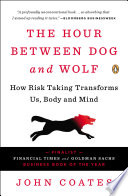

In 'The Hour Between Dog and Wolf', author John Coates explores how stress can profoundly influence our decision-making processes. Coates, a former trader and neuroscientist, draws on both his personal experiences and scientific research to illustrate that under stress, our brains can revert to primal instincts. This is particularly relevant in high-stakes environments such as trading, where the pressure can lead to impulsive decisions driven by fear or greed rather than rational thought. The book delves into the neurobiological mechanisms behind stress, explaining how it affects hormone levels, neurotransmitter functions, and ultimately, our behavior. Coates emphasizes the importance of understanding these effects to improve decision-making, suggesting strategies for managing stress in order to maintain clarity of thought and rationality. The idea is that by recognizing the signs of stress and its potential to cloud judgment, individuals can take proactive steps to mitigate its impact, leading to better outcomes in both personal and professional contexts.
Continue readingCoates argues that there is a deep-seated connection between our biological responses and financial markets. He posits that traders' physiological states—such as adrenaline and cortisol levels—can significantly influence market behavior. This connection challenges the traditional view of finance as a purely rational domain, suggesting that market movements can be better understood through the lens of human biology. By examining how traders' emotional and physiological states affect their performance, Coates highlights the importance of incorporating psychological and biological insights into financial theory and practice. This idea encourages a more holistic view of trading and investing, where understanding human behavior and its biological underpinnings can lead to improved strategies and outcomes in the financial world.
Continue readingThe environment in which individuals operate plays a crucial role in shaping their behavior, especially in high-pressure situations. Coates discusses how the trading floor, with its chaotic and competitive atmosphere, can amplify stress and lead to irrational decision-making. He emphasizes that understanding the impact of the environment on behavior is essential for creating conditions that foster better decision-making. This includes recognizing the importance of social dynamics, competition, and even the physical layout of workspaces. Coates suggests that by designing environments that reduce stress and promote collaboration, organizations can enhance performance and well-being among their employees. This idea extends beyond finance, offering insights applicable to various fields, including business management and organizational behavior.
Continue readingSelf-awareness is a recurring theme in 'The Hour Between Dog and Wolf.' Coates argues that understanding one's own physiological and emotional responses is critical for effective decision-making. Traders and professionals in high-stress environments must cultivate self-awareness to identify when they are being influenced by stress or other emotional factors. This awareness allows individuals to take corrective actions, such as stepping back to reassess a situation or employing techniques to manage stress. Coates provides practical advice on developing self-awareness, including mindfulness practices and reflective exercises. Ultimately, he posits that self-awareness is not just beneficial for individual performance but can also enhance team dynamics and organizational culture.
Continue readingCoates critiques traditional economic models that often assume rational behavior and ignore the complexities of human psychology and biology. He argues that these models fail to account for the emotional and physiological factors that drive decision-making, particularly in volatile markets. By highlighting the limitations of these models, Coates advocates for a more interdisciplinary approach that incorporates insights from neuroscience, psychology, and behavioral economics. This perspective challenges the notion that markets are always efficient and rational, suggesting instead that they are often influenced by human emotions and biological responses. This idea encourages readers to rethink their understanding of economics and finance and to consider the broader implications of human behavior on market dynamics.
Continue readingThe book explores the intricate relationship between risk and reward, particularly in the context of trading and investment. Coates explains that as individuals experience success, their confidence can lead them to take on greater risks, which can result in both significant rewards and devastating losses. This cycle is influenced by biological factors, such as dopamine release, which reinforces risk-taking behavior. Coates warns that without proper self-awareness and control, individuals can fall into a dangerous cycle of overconfidence and reckless decision-making. He emphasizes the importance of maintaining a balanced perspective on risk and reward, suggesting strategies to manage risk effectively while still pursuing opportunities for growth and success.
Continue readingIn the face of stress and uncertainty, resilience becomes a critical trait for success. Coates discusses various strategies that individuals and organizations can employ to build resilience and adapt to changing circumstances. This includes fostering a supportive culture, encouraging open communication, and providing resources for stress management. Coates also highlights the importance of learning from failures and setbacks, viewing them as opportunities for growth rather than obstacles. By cultivating resilience, individuals can better navigate the challenges of high-pressure environments, making more informed decisions and maintaining their well-being in the process.
Continue reading